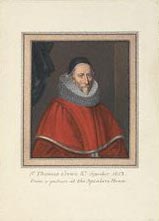
Thomas Crewe
Encyclopedia

Northamptonshire
Northamptonshire is a landlocked county in the English East Midlands, with a population of 629,676 as at the 2001 census. It has boundaries with the ceremonial counties of Warwickshire to the west, Leicestershire and Rutland to the north, Cambridgeshire to the east, Bedfordshire to the south-east,...
, was an English Member of Parliament
Member of Parliament
A Member of Parliament is a representative of the voters to a :parliament. In many countries with bicameral parliaments, the term applies specifically to members of the lower house, as upper houses often have a different title, such as senate, and thus also have different titles for its members,...
and lawyer, and served as Speaker of the House of Commons
Speaker of the British House of Commons
The Speaker of the House of Commons is the presiding officer of the House of Commons, the United Kingdom's lower chamber of Parliament. The current Speaker is John Bercow, who was elected on 22 June 2009, following the resignation of Michael Martin...
from 1623 to 1625.
Crewe was a member of Gray's Inn
Gray's Inn
The Honourable Society of Gray's Inn, commonly known as Gray's Inn, is one of the four Inns of Court in London. To be called to the Bar and practise as a barrister in England and Wales, an individual must belong to one of these Inns...
, and a serjeant-at-law
Serjeant-at-law
The Serjeants-at-Law was an order of barristers at the English bar. The position of Serjeant-at-Law , or Sergeant-Counter, was centuries old; there are writs dating to 1300 which identify them as descended from figures in France prior to the Norman Conquest...
. He entered Parliament in 1604 as Member for Lichfield
Lichfield (UK Parliament constituency)
Lichfield is a constituency represented in the House of Commons of the Parliament of the United Kingdom. It elects one Member of Parliament by the first past the post system of election.- Boundaries :...
, and was later MP for Northampton
Northampton (UK Parliament constituency)
Northampton was a parliamentary constituency centred on the town of Northampton which existed until 1974.It returned two Members of Parliament to the House of Commons of the Parliament of the United Kingdom until its representation was reduced to one member for the 1918 general election...
(1621-2), Aylesbury
Aylesbury (UK Parliament constituency)
Aylesbury is a parliamentary constituency represented in the House of Commons of the United Kingdom. The Conservative Party has held the seat since 1924, and held it at the 2010 general election with a 52.2% share of the vote.-Boundaries:...
(1623-5) and Gatton
Gatton (UK Parliament constituency)
Gatton was a parliamentary borough in Surrey, one of the most notorious of all the rotten boroughs. It elected two Members of Parliament to the House of Commons from 1450 until 1832, when the constituency was abolished by the Great Reform Act...
(1625). In 1621 he drew attention to himself by defying the King
James I of England
James VI and I was King of Scots as James VI from 24 July 1567 and King of England and Ireland as James I from the union of the English and Scottish crowns on 24 March 1603...
, declaring the liberties of Parliament to be "matters of inheritance". In 1623 he was knighted, and in the Parliament summoned that year (which first assembled in February 1624) he was elected Speaker; he served in that capacity in the two Parliaments known to history as the Happy Parliament
Happy Parliament
The Happy Parliament was the fourth and last Parliament of England of the reign of King James I, sitting from 19 February 1624 to 24 May 1624 and then from 2 November 1624 to 16 February 1625...
and the Useless Parliament
Useless Parliament
The Useless Parliament was the first Parliament of England of the reign of King Charles I, sitting only from June until August 1625. It gained its name because it transacted no significant business, making it 'useless' from the king's point of view...
. In 1633, he was appointed a member of the ecclesiastical commission. He died the following year.
Crewe's son, John
John Crew, 1st Baron Crew
John Crew, 1st Baron Crew of Stene was an English Puritan politician, who sided with the Parliamentary cause during the Civil War but was raised to a peerage by Charles II after the Restoration.-Career:...
, followed him into Parliament, and was raised to the peerage as Baron Crew
Baron Crew
Baron Crew, of Stene in the County of Northampton, was a title in the Peerage of England. It was created on 20 April 1661 for the politician John Crew. He was the son of Sir Thomas Crewe, Speaker of the House of Commons. Lord Crew was succeeded by his eldest son, the second Baron. He sat as Member...
in 1661 for his role in bringing about the Restoration
English Restoration
The Restoration of the English monarchy began in 1660 when the English, Scottish and Irish monarchies were all restored under Charles II after the Interregnum that followed the Wars of the Three Kingdoms...
.
Sir Thomas Crew married Temperance Bray, daughter of Reynold Bray and Hon. Anne Vaux. He lived at Stene, Northamptonshire, and died on 31 January 1633.

